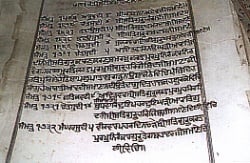Gurdwara Nanak Shahi, Dhaka
Gurdwara Nanak Shahi, Dhaka is one of the seven known Gurdwaras in Bangladesh. It is the most important historic Gurdwara, commemorating the visit of Guru Nanak in 1506-1507. This Gurdwara is said to have been built in 1830. Besides, the founder Guru, Sri Guru Tegh Bahadur, the ninth Guru of the Sikhs also stayed at Dhaka for over two years.
The news of the birth of his only son Sri Gobind Rai - Guru Gobind Singh ji Maharaj - in Patna was received by Guru Tegh Bahadur when he was sojourning in Dhaka. This gurdwaras is among the few places outside India which was graced more than once by Guru Baba Nanak. Its historic and religious importance outside India is second perhaps only to the Gurdwaras of Nankana Sahib and Panja Sahib.
The present building of the Gurdwara was renovated in 1988-1989 and a parkarma verandah has been constructed on all four sides of the original building to protect it from wear and tear. This was a massive task completed with the help of overseas Sikhs under the supervision - and at the initiative - of this writer who was posted at Dhaka as Chairman, International Jute Organisation. During my many tours and travels to various countries I was successful in mobilizing support and collecting a sufficiently large sum of money for the purpose.
A beautiful rose garden has been laid out in the front yard, with about 100 rose plants and about 200 beauty plants, further beautification was planned and remains overdue. The present building of the gurdwara was shown to the public by Bangladesh Television authorities on Dhaka TV Network on 16th May, 1990. During the programme, it was stated by the Director of National Museum that this Gurdwara was "the foremost among the ancient historical buildings existing in the Dhaka City".
Background
Fewer than 10 Sikh Families reside in Bangladesh. They are all here transitorily, mostly officers and staff of Indian High Commission. The Ministry of External Affairs have - thoughtfully - continued to post three Sikh families at Dhaka High Commission, right from 1972, under a tacit understanding. The Gurdwara has become a social forum for all the employees of High Commission of India in Dhaka and a few other Sikhs attached to United Nations Organisation and similar agencies and employees of Sikh contractors, who holy contracts in Bangladesh. They all assemble here on Fridays and on Guru Nanak Birthdays and Vaisakhi.
There are no permanent Sikh residents in this country. Only a Granthi appointed by Takht Patna Sahib looks after the two Gurdwaras in Dhaka, However, Kirtan is conducted every Friday, where devotees professing different faiths - Sikh, Hindu and Muslims and others, recite Gurbani Shabads in praise of God, the true Creator. Free weekly langar is regularly served on these days without any distinction of caste or creed.
Sikh Relics
There are two hand-written Birs (Recensions) of Guru Granth Sahib in the Gurdwara, one of 18 x 12 inches with 1336 pages. Each page is decorated with art work on borders in seven different colours. The significance of this Bir lies in being a Relic rather than Granth Sahib per se. It weighs about 80 lbs and the leaves may wear out if used for reading.
Accordingly, it has recently been rebound and placed in a glass case,. along with other manuscripts, photostat copies of some Hukam Namas (Original Hukam Namas were reported to be stolen), and a pair of Guru Tegh Bahadur’s wooden Kharavan (sandals) handed down from generation to generation are also kept in the show case. The last custodian being Mata Kanchan Devi, locally called Sikher Mata, or mother of the Sikhs. Devotees can view a document issued under Imperial (Aurangzeb) Farman by the then Mughal Governor, Shaista Khan, granting land to Guru Nanak Home exempted from taxes in perpetuity.
Mata Kanchan Devi
During the Pakistan Army crackdown in Bangladesh in 1971, Mata Kanchan Devi was evacuated to Calcutta, along with the precious and beautiful Bir, where she died at the age of 110 years. The Bir was brought back by Captain Bhag Singh to this Gurdwara. The unique Bir and a water-colour painting of Guru Tegh Bahadur, sandals and other Relics, were retrieved from the house which later came to be known as Gurdwara Sangat Tola situated in old Dhaka, was especially built by Bhai Bulaki, the Cardinal of Sikh church in old Dhaka, which remained the abode of Guru Tegh Bahadur for about two years.
Guru's painting
An oil painting, copy of the original painting of the Guru, is kept in Nanak Shahi Gurdwara. The original water colour painting was retrieved from the house which later came to known as Gurdwara Sangat Tola. His mother, a devout lady wanted to have a portrait of the Guru made, before the Guru returned to Punjab. The old lady engaged a renowned painter, Ahsan by name. The painter painted the body and the apparel but could not give finishing touches to the radiant face of the Guru. Seeing the painter in a predicament, the Guru took the brush in his own hand, corrected and completed the picture, and handed it to the lady. It is thus stated in Mehma Prakash, one of the oldest biography of the Guru:-
"bada likhari leai mai satguru hazur tasvir likhai sagal ang bastr subh likha mukh kamal Prabhu nahin likh saka dekh Dial kalam hath lina nij hath sudhar sampuran kina tab mai ko murat Prabh dina".
This painting is now believed to be in custody of the Victoria Museum Calcutta, where it was taken to be restored in its torn part and for preservation treatment, by the Late Captain Bhag Singhji. (efforts are being made to trace the documents appertaining to this entrustment - Ed. S.R).
Invitation to worldwide sangat
The lack of knowledge among the Sikhs in India and abroad about the two sacred shrines needs to be rectified. The best way is to start an annual pilgrimage of these Gurdwaras, on the lines of Gurdwaras at Nankana Sahib in Punjab, Pakistan.
The Sikh devotees temporarily stationed here invite individuals and jathas of devotees for pilgrimage to this historic/religious shrine on the occasion of Guru Baba Nanak’s birth anniversary in November. Their boarding and lodging, upto a week of their stay here, will be duly taken care of. The weather in November in Bangladesh is pleasant and half-sleeve shirt may be worn day and night. For sleeping one will need a pillow and a bedsheet, which the devotees are recommended to bring for themselves.
This invitation may also be used as a document for obtaining the necessary visas for the members of the jatha. Subject to its conformity with the Sikh maryada, each pilgrim will, if he/she so desires, be supplied with a 1000 page hard-bound photocopy of the smaller hand-written Granth Sahib at the photocopying cost of Rs. 500 (US$ 30).
Pilgrims coming to Dhaka to visit these two shrines can as well visit Chittagong and see the Sikh Temple where Guru Nanak stayed for a time with two of this disciples. Raja Sudhir Sen of Chittagong became his disciple, Guru Nanak appointed one, Jhanda, the first Cardinal of the faith in Chittagong. In later times, the temple was erected by Diwan Mohan Singh, a Behari Sikh who was the Diwan of Nawab Murshid Kuli Khan of Bengal, and extensive properties yielding income of about Rs. 5000/- were endowed for the maintenance of the shrine. The Nawab made the endowed properties rent-free, and the grant perpetuated the said endowment. The endowment was recognised and confirmed as a Sikh religious endowment by the Government, as would appear from a letter No. 318 A of 7th May 1878 from the Secretary to the Board of Revenue L.P. to the Secretary to then Government of Bengal Revenue Department.
What is left of it now is not less than 3 acres in Mauzah Khizirpur, and other 23 Mauzahs 15-20 miles off Chittagong. The first Secretary-General, Capt. Bhag Singh [Editor, The Sikh Review, Calcutta] visited some of these fertile lush lands; claims have been lodged for full ownership of the Sikh temple by a local committee, its members were selected and proposed by Capt. Bhag Singh, and appointed by the District Judge, Chittagong, who remains the Ex-Official Administrator of the Sikh Temple property, vide 1931 order of the Calcutta High Court. We hope, one day, this tangle will be solved.
Sorry State of Bangladesh Gurdwaras
- A report by Prof. Harnam Singh Shan* (Sikh Review April 2003)
Prof. Harnam Singh Shan, former Chairman of Guru Nanak Chair and Head of Panjabi and Sikh Studies at Panjab University, Chandigarh, recently returned from Bangladesh after participating in the 17th Conference of the International Association of Historians of Asia, where he presented a Paper on Cultural Heritage of South Asia.
After the Conference, Prof. Shan paid obeisance at the historic Sikh shrines, and had a look at the relics associated with Guru Nanak (1504 A.D.) and Guru Tegh Bahadur (1666 A.D.). These shrines have remained neglected ever since the Partition of India in 1947, because access to these had been denied to the Sikhs during the Pakistani regime.
According to Dr. Shan’s finding, the first holy shrine was at the spot where Guru Nanak had a public well dug and a dharamshala built. This came to be known as Rayer Bazar Gurdwara. This is indicated in Burt’s and Hassan’s works, but stands wholly obliterated. It was around 1960 that the East Pakistan authorities demolished the building, levelled the well (known and revered as Guru Nanak’s well) and the land attached to it, carved out plots, auctioned for house building. On that site now stands modern bungalows, and the locality, called Dhan Mandi, is now the leading posh colony of Dhaka, the capital of Bangladesh.
On the other hand, Gurdwara Nanak Shahi, still stands at its original site, in the heart of the city adjacent to the Dhaka University. However, it has been deprived of its vast estate, mostly encroached upon by authorities. It has been renovated by means of a grant by the Indian High commission and generous donations received from Sikh devotees of Calcutta, Bangkok, Singapore & the Far East, thanks to ex-Director, I.J.O., Sr. Harbans Singh.
The second existing shrine, Gurdwara Sangat Tola, is located in the Bangla Bazar. Guru Tegh Bahadur stayed here on his way to Assam. It is in a highly dilapidated condition and requires immediate repairs and renovation. Its housing complex, worth crores of rupees, is under unauthorised occupation.
The Udasi mahants and the Sikh residents, who had been revering and managing them, had to leave East Bengal soon after the establishment of Pakistan. None except a lone brave Sikh, Bhai Swaran Singh, the last Granthi of the Nanak Shahi Gurdwara, remained there to look after them. He too, alongwith Mohd-ul-Malik Haq, his Muslim friend, was shot dead by Pakistani Razakars during the Pakistan army’s crackdown in 1971. There is now not a single Sikh citizen in Bangladesh who could look after such holy and historical places and the vast property attached to them.
As regards the relics, only one out of the five old, handwritten and dated recensions of Guru Granth Sahib, noticed and described by Sardar G.B. Singh in 1945 and Captain Bhag Singh in 1971, is now extant. That too is in a highly dilapidated condition and the page expected to bear its date is washed out.
The only other extant relic is a pair of Kharavan (wooden sandals) placed on a chauki (a low wooden stool), used by Guru Tegh Bahadur and bestowed upon Balaki Ram on the eve of his departure for Assam. The original painting of the Guru, drawn by a contemporary painter of Shaista Khan’s court, is also missing and its beautiful colour copy stands exhibited alongwith the above holy items in the said Gurdwara Nanak Shahi.
The two hukumnamas (edicts) of Guru Gobind Singh, addressed to the Dhaka Sangat, found in Gurdwara Sangat Tola at the time of the surrender of Pakistani Army to General Jagjit Singh Arora, are no longer available there.
In order to preserve all that which is now extant, to retrieve all that which has been usurped, or is occupied without authorised, and to re-establish the desecrated and obliterated one, Shiromani Gurdwara Parbandhak Committee, Amritsar should take immediate necessary steps with due permission and help of the Bangladesh Government and in collaboration with the Sikh organisations of West Bengal and the neighbouring countries (such as Singapore, Malaysia, Thailand and Japan) as well as of the NRIs of the UK and USA, etc. under the kind advice of the Indian High commission in Bangladesh.
At present only a non-official committee, called the Bangladesh Gurdwara Management Board, Calcutta, is engaged in make-shift arrangements for their upkeep under very peculiar circumstances. A weekly congregation is held by it in Gurdwara Nanakshahi, on every Friday, which is attended mostly by the devoted staff of the Indian High Commission, some Sikh devotees from the neighbouring lands and some devout Hindu residents of Dhaka.
An article in Sikh Review
sikhreview.org From an An article in Sikh Review, by Harbans Singh Ias Gurdwara Nanak Shahi (Bengali: গঢ়রঢ়দঢ়য়ারা নানকশাহী) is a Sikh Gurdwara at Dhaka, Bangladesh. It is located at the campus of the University of Dhaka and considered to be the biggest of 9 to 10 Gurdwaras in the country.[1] According to the commemorating the visit of Guru Nanak (1506-1507), it is the most important historic place.[citation needed] It is said to have been built in 1830. The present building of the Gurdwara was renovated in 1988-1989. The parkarma verandah had been constructed on all four sides of the original building to protect.
Sikh Relics
There are two hand-written Birs (Recensions) of Guru Granth Sahib in the Gurdwara, one of 18 x 12 inches with 1336 pages.
Religious rituals
Gurdwara Nanak Shahi is open for people of all religions. Each day, recitation from the holy scripture of Sikh religion Granth Sahib and prayer takes place in Gurdwara Nanak Shahi. Weekly prayer and Kirtan are organized every Friday. On this day in the morning and after prayer, free food known as langar is served.[1]
A second article
Gurdwara Nanak Shahi the main Sikh gurdwara in Bangladesh, is situated on the campus of the university of dhaka near the arts faculty building. At one time it was known as 'Sujatpur Sikh Sangat', as it was situated in what was then Sujatpur mouza. It is believed to have been built on the initiative of a Sikh priest, Almast, sent by the sixth Sikh guru, Hargobind Singh (1595-1644), during the reign of Emperor jahangir. Some others believe it was built by the ninth Sikh guru, Teg Bahadur Singh (1621-75), and that from here communication was maintained with other Sikh gurdwaras in Bengal, Bihar and Orissa.
This shrine, commemorating Guru Nanak's visit, is located close to the Dacca University. For some years in the recent past, the place had suffered neglect, and it was on the 2nd January 1972, after the liberation of Bangladesh, that Sri Guru Granth Sahib was installed again at the shrine. The room where the congregation met was 9 by 9 meters. Towards the left is an ancient tank, newly cleared of debris, with a baoli in its midst.
The Gurdwara was founded by a missionary sent to Bangladesh by Baba Gurditta, son of Guru Hargobing (6th Guru) within 17th century and was completed in 1830. Religious celebrations include weekly prayers every Friday. Social functions such as Baishakhi are celebrated. Old relics-an old handwritten volume of Guru Granth Sahib, a copy of the Portrait of Guru Teg Bahadur and Guru Teg Bahdur's sandals are preserved here Suitable accommodation is available for visitors.
Gurdwara Nanakshahi in Ramana behind the public library adjoining the Dacca University campus, was originally an Udasi Charan-Paduka founded by Baba Nath, successor of Bhai Almast, in memory of Guru Nanak Dev. When Guru Tegh Bahadur was at Dacca during the late 1660s, Bhai Nattha was the Udasi mahant and Baba Bulaki Das the Guru's masand here. On the eve of the Partition, possession and priesthood was the subject of court cases between Baba Tribeni Das and another claimant Gobind Das, and later between Tribeni Das and one Manik Lal. Ultimately Tribeni Das was adjudged the lawful guardian of the Gurdwara, but in the wake of the Partition, he left for India never to return. A Sikh, Swarn Singh looked after this place in his absence. In 1960-61, the east Pakistan Government passed order to acquire 1.40 acres of the 1.63 acres of walled premises of the Gurdwara.
Baha Swarn Singh challenged the government in lower courts and ultimately in Dacca High Court. The case was pending there when Indo-Pak War started in December 1971. On or about 14th December 1971, Baba Swarn Singh was murdered alongwith his Muslim friend Muhammad-ul-Malik. Their bodies were buried side by side in the later's house. After the conclusion of the war three days later, a Sikh deputation was sent from Takht Sri Patna Sahib to Dacca. With the help of Sikh soldiers the members of the deputation led by Captain Bhag Singh of Calcutta recovered possession of the Gurdwara, cleaned it and held a congregation in it on 2nd January, 1972. Even Sayyad Nazar-ul-Islam, then acting President of Bangla Desh attended the congregation and gave assurance about the safety and reconstruction of this and the other Gurdwaras.
In the past it had an entrance from the north, a ditch and burial ground on the south, and a pond on the west with concrete steps to the water. Apart from the main temple there were a number of rooms for accommodating devotees. In all, there were nine rooms. On the north-east of the main temple there was an office and on the east the granthi (priest) had his residence.
From 1915 to 1947, Sri Chandrajyoti served as the granthi. After 1947 the gurdwara was neglected and almost abandoned. After the liberation of Bangladesh, however, it was repaired and revived. There is a management board, which includes local as well as foreign members, to run the affairs of the gurdwara.
The gurdwara is open to all, irrespective of race, religion, caste or sex. The place of prayer is known as 'darbar sahib' and has entrances on all sides, unlike other places of worship. At the northern end of the prayer hall a copy of the holy book of the Sikhs, the granth shahib, is kept on a wooden platform. A pair of wooden sandals, believed to belong to Guru Teg Bahadur Singh, has been preserved in a glass box just under the Granth Sahib.
The daily religious rites at the gurdwara include reading from the Granth Sahib and recital of prayers. Every Friday a weekly assembly is held from 11 am to 1 pm. The chief granthi reads from the Granth Sahib. kirtan and prayers continue for over two hours. The prayer service ends with the distribution of food. There are also arrangements to distribute food in the morning. Sikhs regard this as a way of enhancing understanding among people.
There are also about eight or nine smaller gurdwaras in different parts of Bangladesh. The Bangladesh Gurdwara Management Committee runs the affairs of these gurdwaras with financial support from the devotees, foreign visitors, donors and grants from the Bangladesh government. [Sambaru Chandra Mohanta]
Location: Neelkhet Road, Ramna, Dhaka (Bangladesh)
News
New Langar
Laying of Foundation Stones: Gurdwara Nanakshahi (Dhaka), 20 April, 2007.
It is also our pleasure to announce that, in memory of Mahapurkh Bhram Giani Sant Baba Tara Singh ji, foundation stones for a new langgar hall (free kitchen) and seraa (accomodation building for visitors) will be laid at Gurdwara Nanakshahi, Dhaka, by the Indian High Commissioner Shri Pinak Ranjan Chakravarty .
A sehaj paath will be held to mark the occassion and paath da bhog will be on 20 April 2007. All members of the sangat are cordially invited to attend. (Sampardai Kaar Sewa Sarhali Sahib - www.Gurpuri.com, Punjab, India)
Sikh priest wins hearts
Sikh priest wins hearts in Muslim Bangladesh Mon Jan 22, 2007 by Azad Majumder
DHAKA (Reuters Life!) - Practising what he preaches has won Sikh priest Bhai Piara Singh many admirers in Dhaka, the capital of overwhelming Muslim Bangladesh.
Singh came to Bangladesh eight years ago from India to head the main Gurdwara, or Sikh temple, in Dhaka, where his doctrine of peace and generosity to all mankind has made its mark on Bengalis of all faiths -- and helped keep his community safe.
"People respect us," Singh told Reuters. "Often I get a chance to speak at inter-religion discussions."
"Never we had a communal problem nor did I hear of any. People of all religions visit us. Muslims often donate (money) to help us run the Gurdwara," he added.
Sectarian violence has often erupted in impoverished Bangladesh, which is also wrecked by political unrest. Sunni Muslim militants have attacked other Muslim sects and bombed churches within the past few years.
But the Gurdwara, which is inside Dhaka University's campus, has so far been spared. The century-old building is protected by the authorities but also fondly preserved by students, who often engage in gun battles on campus.
"All religions preach non-violence, no hatred and love. The Sikhs are a true reflection of that and so they are loved by all," said Atiqur Rahman, Muslim who attended Dhaka University..
RECENT EFFORTS OF BABA SUKHA SINGH OF SIRHALI PUNJAB
GURDWĀRĀ NĀNAKSHĀHĪ, situated in Ramnĝ locality behind the Public Library adjoining the Dhĝkĝ University campus, marks the spot where Gurū Nĝnak is believed to have preached at the time of his visit in 1507-08. Bulĝkī Dĝs was the masand at the time of Gurū Tegh Bahĝdur's visit in the late 1660's. Bhĝī Natthĝ, who lived up to the time of Gurū Tegh Bahĝdur, is said to have constructed the Gurdwĝrĝ building, with a square sanctum, which still exists. It was repaired by Mahant Prem Dĝs in 1833. The decorative art work on the interior wall was still intact when a Sikh commission visited it in January 1972 after Bangladesh emerged as a soverign State. A tank and a well, also said to have been dug by Bhĝī Natthĝ, however, no longer exist.
A Sikh Research Centre has been established in gurdwara premises with efforts of Baba Sukha Singh of Sarhali Punjab India as per a news report of Times of India. in picture Baba ji si seen with VC of Dhaka University and deputy high commissioner Dhaka(a lady) who is general secretary of Bangladesh Gurdwaras Board in present times(2010)
Dhaka Gurdwara gets Sikh History Research Centre(full report) There is virtually no Sikh population in Dhaka, Bangladesh, yet a Sikh History Research Centre has been established in the complex of Gurdwara Nanak Shahi by Sampradaya Karsewa, Sarhali (Punjab) for the research and propagation of Sikhism. Kazi Nurul Islam, Founder Chairman of the Department of World Religions, has been appointed as its honorary director. “Our aim is to build a bridge between Sikhism and other religions so that everyone can know about the distinct identity of a Sikh, their rituals, way of life, etc.,” said Sukha Singh, chief of Sampardaya, while talking to TOI. He returned to India after the inauguration of Sikh Research Centre by Mukta D Tomar, deputy high commissioner of the Indian High Commission in Bangladesh, and Arefin Siddique, vice-chancellor of Dhaka University. Sukha Singh stated that there was a strong desire among Bangla Muslim students to study Sikhism. Presently 42 students were studying it, he said, adding that they were also planning to arrange a tour of religious places in Indian for these students. He further said there were many Hindu and Muslim followers of Sikhism who regularly hold religious functions at the Gurdwara. Every Friday, more than 500 Hindus and a few Muslims gather at the Gurdwara to hold religious prayers, followed by langar, he averred. The Sampardaya has also made a large langar hall in the Gurdwara besides a sarai having seven rooms. The kar sewa being carried out with financial help from followers of Sampardaya spread across the world, he added. It has now begun ‘kar sewa’ of Gurdwara Punjabi Lane in Chittagong, about 250 km from Dhaka, he stated. [Courtesy: The Times of India]
External links
- Gurdwara Nanak Shahi: A spiritual refuge
- allaboutsikhs.com
- Sikh priest wins hearts in Muslim Bangladesh
- SGPC to repair Bangladesh gurdwaras
- ‘Protect Sikh shrines in Bangladesh’
Gallery
- Picture Gallery
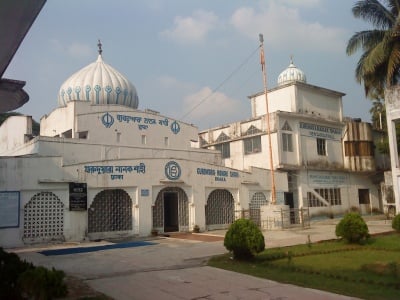
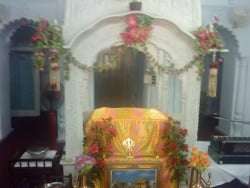
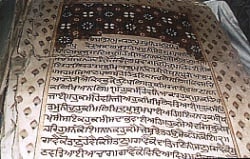

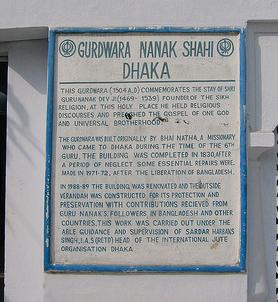
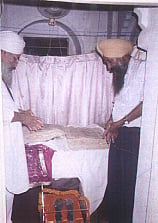
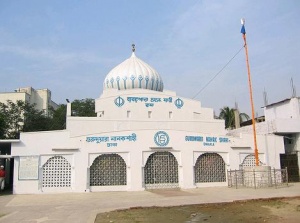
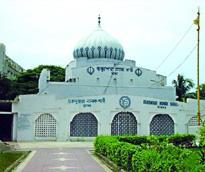
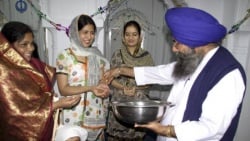
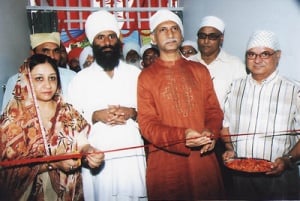
![GURDWARA NANAK SHAHI,Nilkhet Road ,Ramna DHAKA(near teachers students centre ,Dhaka University)]]](/images/thumb/1/1a/Gurdwara_nanak_shahi_dhaka1.JPG/250px-Gurdwara_nanak_shahi_dhaka1.JPG)
